Effect of temperature on betacyanins synthesis and the transcriptome of Suaeda salsa
- PMID: 37434603
- PMCID: PMC10330703
- DOI: 10.3389/fpls.2023.1203089
Effect of temperature on betacyanins synthesis and the transcriptome of Suaeda salsa
Abstract
Introduction: Suaeda salsa (Linn.) Pall. is an important tourist resource and ecological restoration species in coastal wetlands. Environmental factors such as low temperature, darkness, phytohormone, salt stress and seawater flflooding, and light can induce betalain synthesis in S. salsa, which plays an important role in plant adaptation to abiotic stress processes and in shaping the beautiful "red beach" landscape.
Methods: In this study, Illumina sequencing was used to profifile the transcriptome sequence (RNA-Seq) of S. salsa leaves at different temperatures (5° C, 10°C, 15°C, 20°C, 25°C, and 30°C) and to validate differentially expressed genes (DEGs) indicated by real-time PCR (RT-qPCR).
Results: The betacyanin content was highest in S. salsa leaves at 15°C. Transcription group data showed that compared to the control group (15°C), the "betacyanin biosynthesis pathway" was signifificantly enriched in the fifive different temperature groups. KEGG analysis showed that the DEGs were mainly involved in pathways of phenylpropanoid biosynthesis, carbon fifixation in photosynthetic organisms, flflavonoid biosynthesis, and betacyanin biosynthesis. Among the key enzymes involved in biosynthesis of betacyanin, genes for tyrosinase, CYP76AD1 and 4,5-DOPA dioxygenase were signifificantly upregulated and most abundantly expressed at 15°C. It is possible that the gene for betacyanin synthesis from S. salsa is primarily regulated by the MYB1R1 and MYB1 transcription factor. Four DEGs were randomly selected for quantitative PCR analysis, and DEG expression was generally consistent with the RNA-Seq data, verifying the validity of the transcriptome sequencing data.
Discussion: Relative to other temperatures, 15°C was optimum for S. salsa betacyanin synthesis, and this provides a theoretical reference for coastal wetland ecological remediation, reveals mechanisms of S. salsa discoloration, and further mines its potential application for landscape vegetation.
Keywords: Suaeda salsa; betacyanins; coastal wetlands; temperature; transcriptome.
Copyright © 2023 Li, He, Zhao, Liu, Liu, Ma, Shen and Li.
Conflict of interest statement
The authors declare that the research was conducted in the absence of any commercial or financial relationships that could be construed as a potential conflict of interest.
Figures


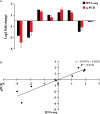
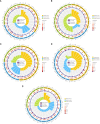
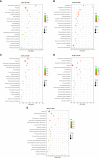


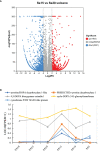

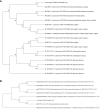
Similar articles
-
Betacyanin accumulation mediates photosynthetic protection in Suaeda salsa (L.) Pall. under salt stress.Planta. 2025 Apr 1;261(5):100. doi: 10.1007/s00425-025-04664-7. Planta. 2025. PMID: 40167794
-
Comparative Transcriptome Analysis Reveals Mechanisms of Differential Salinity Tolerance Between Suaeda glauca and Suaeda salsa.Genes (Basel). 2024 Dec 19;15(12):1628. doi: 10.3390/genes15121628. Genes (Basel). 2024. PMID: 39766895 Free PMC article.
-
Cryptochrome 2 is involved in betacyanin decomposition induced by blue light in Suaeda salsa.Funct Plant Biol. 2006 Jul;33(7):697-702. doi: 10.1071/FP06073. Funct Plant Biol. 2006. PMID: 32689278
-
Identifying loss threshold and migration trajectory in the management of Suaeda salsa wetland under coastal squeeze.Mar Environ Res. 2024 Feb;194:106329. doi: 10.1016/j.marenvres.2023.106329. Epub 2023 Dec 25. Mar Environ Res. 2024. PMID: 38159408
-
Identification of betacyanin and effects of environmental factors on its accumulation in halophyte Suaeda salsa.Zhi Wu Sheng Li Yu Fen Zi Sheng Wu Xue Xue Bao. 2006 Apr;32(2):195-201. Zhi Wu Sheng Li Yu Fen Zi Sheng Wu Xue Xue Bao. 2006. PMID: 16622319
Cited by
-
Amaranth Plants with Various Color Phenotypes Recruit Different Soil Microorganisms in the Rhizosphere.Plants (Basel). 2024 Aug 8;13(16):2200. doi: 10.3390/plants13162200. Plants (Basel). 2024. PMID: 39204636 Free PMC article.
-
Microbial community assembly and functional profiles along the soil-root continuum of salt-tolerant Suaeda glauca and Suaeda salsa.Front Plant Sci. 2023 Nov 17;14:1301117. doi: 10.3389/fpls.2023.1301117. eCollection 2023. Front Plant Sci. 2023. PMID: 38046600 Free PMC article.
-
Pectin-Based Active and Smart Film Packaging: A Comprehensive Review of Recent Advancements in Antimicrobial, Antioxidant, and Smart Colorimetric Systems for Enhanced Food Preservation.Molecules. 2025 Mar 3;30(5):1144. doi: 10.3390/molecules30051144. Molecules. 2025. PMID: 40076367 Free PMC article. Review.
-
Betacyanin accumulation mediates photosynthetic protection in Suaeda salsa (L.) Pall. under salt stress.Planta. 2025 Apr 1;261(5):100. doi: 10.1007/s00425-025-04664-7. Planta. 2025. PMID: 40167794
References
-
- Chen J., Xie F. F., Shah K., Chen C. B., Zeng J. M., Chen J. X., et al. . (2023). Identification of HubHLH family and key role of HubHLH159 in betalain biosynthesis by activating the transcription of HuADH1, HuCYP76AD1-1, and HuDODA1 in pitaya . Plant Sci. 328, 111595. doi: 10.1016/j.plantsci.2023.111595 - DOI - PubMed
-
- Cui M. Z. (2020). Biosynthesis of betacyanins in suaeda salsa under the combined stress of low nitrogen, low phosphorus and high salt and its effect on plant salt tolerance (Lanzhou (CN: Lan Zhou University; ).
LinkOut - more resources
Full Text Sources

